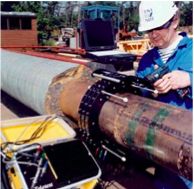The integrity of pipelines is a natural concern for pipeline operators, and so the ability to detect corrosion, erosion and mechanical damage in pipes is therefore of significant interest. Traditional methods of detection, such as pigging and crawlers, have been used for many years to inspect pipelines with great success.
Particular benefits of these methods include their ability to inspect long lengths of pipe in a short period of time and pipes that are inaccessible (buried, placed on the sea bed or encased in protective coatings). The fact that the pipes don’t actually have to be emptied for inspection is a further advantage.
However, these techniques do have their limitations. For example, the use of pigs requires entry and exit points, and pipe bends and steep gradients can prevent the pig from passing through the pipe. As a result, a significant portion of all pipelines cannot be inspected by pigs. In situations where pipelines are in close proximity to one another, the use of external crawlers along the entire length of the pipeline becomes impractical (Figure 1). Therefore, alternative solutions need to be considered for inspecting pipelines that otherwise prove difficult to inspect.

One such alternative is long-range ultrasonic testing (LRUT) - arguably one of the most significant developments in the field of non-destructive testing to have taken place over the last two decades.
This method was first introduced as a commercial technique when Plant Integrity Ltd (Pi Ltd - a wholly owned subsidiary of TWI Ltd) launched Teletest in 1997 (Figure 2). Since its introduction, this technology has been through a number of development programmes to become the versatile inspection tool it is today.
What does it detect? It is a global monitoring tool for the detection and analysis of metal loss features, such as corrosion and erosion, in pipes. It is capable of measuring significant lengths of pipe (typically 60m, but up to 350m) from a single point, detecting and locating areas of corrosion rapidly. The technique is capable of detecting 9% and greater cross-sectional metal loss flaws. Once these flaws have been located, conventional inspection techniques are deployed to characterise the defects.
How does it work? In LRUT, a pulsed guided ultrasonic wave mode is propagated in a pipe wall from a ring of equally spaced ultrasound probes supported by a collar wrapped round the pipe.The ultrasonic waves are reflected by features such as flanges, circumferential welds, branches and defects in the wall, and the reflected echoes are received by the transmitting probes.Therefore, all features in the entire run of pipe are detected during the same scan, provided the response is large enough to produce an echo amplitude above the random noise level.
The success of the technique stems from the fact that low frequency guided waves can be transmitted a long distance in pipes. This is because:
- absorption of the waves in the pipe material is low due to the low frequencies.
- for pipes in air, leakage of waves out of the pipe is very low because of the high acoustic impedance mismatch at the solid- air boundaries. Therefore, all the energy propagates down the pipe with little attenuation of the energy density (wave amplitude).
- A wave mode with low dispersion (frequency dependence of phase velocity) can be selected so that the rate at which the wave pulse spreads out in time is small.

















Comments and Discussion
There are no comments yet.
Add a Comment
Please log in or register to participate in comments and discussions.